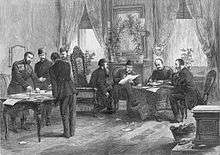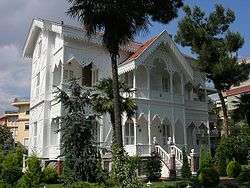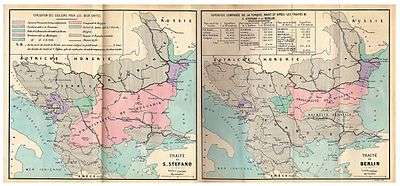Treaty of San Stefano
The 1878 Treaty of San Stefano (Russian: Сан-Стефанский мир; Peace of San-Stefano, Сан-Стефанский мирный договор; Peace treaty of San-Stefano, Turkish: Ayastefanos Muahedesi or Ayastefanos Antlaşması) was a treaty between Russia and the Ottoman Empire signed at San Stefano, then a village west of Constantinople,(nowadays İstanbul) on 3 March [O.S. 19 February] 1878 by Count Nicholas Pavlovich Ignatiev and Aleksandr Nelidov on behalf of the Russian Empire and Foreign Minister Saffet Pasha and Ambassador to Germany Sadullah Bey on behalf of the Ottoman Empire.[1][2] The treaty ended the Russo-Turkish War, 1877–78.[3]
 The signing of the treaty of San Stefano | |
| Type | Bilateral treaty |
|---|---|
| Signed | 3 March 1878 |
| Location | San Stefano, Ottoman Empire |
| Original signatories | Ottoman Empire, Russia |
According to the official Russian position, by signing the treaty, Russia had never intended anything more than a temporary rough draft, so as to enable a final settlement with the other Great Powers.[4][5]
The treaty provided for the creation of an autonomous Principality of Bulgaria following almost 500 years of Ottoman rule. The day the treaty was signed, 3 March [O.S. 19 February] 1878, is celebrated as Liberation Day in Bulgaria. However, the enlarged Bulgaria envisioned by the treaty alarmed neighboring states as well as France and Great Britain. As a result, it was never implemented, being superseded by the Treaty of Berlin following the Congress of the same name that took place three months later.[6]
Effects
On Bulgaria
-byTodorBozhinov.png)
The treaty established the autonomous self-governing Principality of Bulgaria, with a Christian government and the right to keep an army.[7] Though still de jure tributary to the Ottomans, the Principality de facto functioned as an independent nation. Its territory included the plain between the Danube and the Balkan mountain range (Stara Planina), the region of Sofia, Pirot and Vranje in the Morava valley, Northern Thrace, parts of Eastern Thrace and nearly all of Macedonia (Article 6).
Bulgaria would thus have had direct access to the Mediterranean. This carried the potential of Russian ships eventually using Bulgarian Mediterranean ports as naval bases - which the other Great Powers greatly disliked.
A prince elected by the people, approved by Ottoman Empire , and recognized by the Great Powers was to take the helm of the country (Article 7). A council of Bulgarian noblemen was to draft a constitution (also Article 7). (They produced the Tarnovo Constitution.) Ottoman troops were to withdraw from Bulgaria, while Russian troops would remain for two more years (Article 8).
Montenegro, Serbia, and Romania
Under the treaty, Montenegro more than doubled its territory, acquiring formerly Ottoman-controlled areas including the cities of Nikšić, Podgorica, and Bar (Article 1), and the Ottoman Empire recognized its independence (Article 2).
Serbia gained the cities of Niš and Leskovac in Moravian Serbia and became independent (Article 3).
Turkey recognized the independence of Romania (Article 5). Romania gained Northern Dobruja from Russia (to which it was transferred from the Ottoman Empire) and ceded Southern Bessarabia in a forced exchange.
On Russia and the Ottoman Empire

In exchange for the war reparations, the Porte ceded Armenian and Georgian territories in the Caucasus to Russia, including Ardahan, Artvin, Batum, Kars, Olti, Beyazit, and Alashkert. Additionally, it ceded Northern Dobruja, which Russia handed to Romania in exchange for Southern Bessarabia (Article 19).
On other regions
The Vilayet of Bosnia (Bosnia and Herzegovina) was supposed to become an autonomous province (Article 14) like Serbia was; Crete, Epirus and Thessaly were to receive a limited form of local self-government (Article 15), while the Ottomans vouched for their earlier-given promises to handle reforms in Armenia in order to protect the Armenians from abuse (Article 16).
The Straits — the Bosporus and the Dardanelles — were declared open to all neutral ships in war and peacetime (Article 24).
Reaction

The Great Powers, especially British Prime Minister Benjamin Disraeli, were unhappy with this extension of Russian power, and Serbia feared the establishment of Greater Bulgaria would harm its interests in former and remaining Ottoman territories. These reasons prompted the Great Powers to obtain a revision of the treaty at the Congress of Berlin, and substitute the Treaty of Berlin.
Romania, which had contributed significantly to the Russian victory in the war, was extremely disappointed by the treaty, and the Romanian public perceived some of its stipulations as Russia breaking the Russo-Romanian pre-war treaties that guaranteed the integrity of Romanian territory.
Austria-Hungary was disappointed with the treaty as it failed to expand its influence in Bosnia-Herzegovina.
The Albanians, dwelling in provinces controlled by the Ottoman Empire, objected to what they considered a significant loss of their territory to Serbia, Bulgaria, and Montenegro and realized they would have to organize nationally to attract the assistance of foreign powers seeking to neutralize Russia's influence in the region. The implications of the treaty led to the formation of the League of Prizren.[8]
In the "Salisbury Circular" of 1 April 1878, the British Foreign Secretary, Salisbury, made clear his and his government's objections to the Treaty of San Stefano and the favorable position in which it left Russia.
According to British historian A. J. P. Taylor, writing in 1954, "If the treaty of San Stefano had been maintained, both the Ottoman Empire and Austria-Hungary might have survived to the present day. The British, except for [Disraeli] in his wilder moments, had expected less and were therefore less disappointed. Salisbury wrote at the end of 1878 'We shall set up a rickety sort of Turkish rule again south of the Balkans. But it is a mere respite. There is no vitality left in them.'"[9]
Gallery
 Signing of peace treaty, San Stefano
Signing of peace treaty, San Stefano Annex to the Treaty of San Stefano, showing the change of Serbia's borders.
Annex to the Treaty of San Stefano, showing the change of Serbia's borders. Annex to the Treaty of San Stefano, showing the change of Montenegro's borders.
Annex to the Treaty of San Stefano, showing the change of Montenegro's borders. Annex to the Treaty of San Stefano, showing the borders of the new Principality of Bulgaria.
Annex to the Treaty of San Stefano, showing the borders of the new Principality of Bulgaria. Annex to the Treaty of San Stefano, showing the change of the border between the Russian and the Ottoman Empire in the Caucasus.
Annex to the Treaty of San Stefano, showing the change of the border between the Russian and the Ottoman Empire in the Caucasus.
See also
| Wikimedia Commons has media related to Treaty of San Stefano. |
References
- Hertslet, Edward (1891), "Preliminary Treaty of Peace between Russia and Turkey. Signed at San Stefano 19 February/3 March 1878 (Translation)", The Map of Europe by Treaty; which have taken place since the general peace of 1814. With numerous maps and notes, IV (1875-1891) (First ed.), London: Her Majesty's Stationery Office, pp. 2672–2696, retrieved 2013-01-04
- Holland, Thomas Erskine (1885), "The Preliminary Treaty of Peace, signed at San Stefano, 17 March 1878", The European Concert in the Eastern Question and Other Public Acts, Oxford: Clarendon Press, pp. 335–348, retrieved 2013-03-04
- J. D. B. (1910). "Bulgaria (Treaties of San Stefano and Berlin)". The Encyclopaedia Britannica; A Dictionary of Arts, Sciences, Literature and General Information. IV (BISHARIN to CALGARY) (11th ed.). Cambridge, England: At the University Press. p. 782. Retrieved 16 July 2018 – via Internet Archive.
- Holland, Thomas Erskine (1898), "The Execution of the Treaty of Berlin", Studies in International Law, Oxford: Clarendon Press, p. 227, retrieved 2013-02-02
- Although it was inconsistent with the Treaty of Paris of 1856 and with the London Convention of 1871, and for that reason was justly protested by Great Britain, the Preliminary Treaty of Peace of San Stefano was, according to general international law, valid. See Kelsen, Hans (1952), Principles of International Law, New York: Rinehart & Company Inc., p. 365
- Chisholm, Hugh, ed. (1911). . Encyclopædia Britannica (11th ed.). Cambridge University Press.
- Briggs, Asa; Calvin, Patricia (2003). Modern Europe, 1789-Present (2 ed.). London: Routledge. p. 113. ISBN 0582772605.
- Gawrych, George. The Crescent and the Eagle. London: I.B. Tauris, 2006, pp. 44-49.
- Taylor, A. J. P. (1954) The Struggle for Mastery in Europe 1914-1918. Oxford University Press, p. 253.
External links
- "Preliminary Treaty of Peace between Russia and Turkey: Signed at San Stefano, February 19/ March 3, 1878 (Translation)". The American Journal of International Law. II (4, Supplement, Official Documents): 387–401. October 1908. doi:10.2307/2212669. JSTOR 2212669.
- The Preliminary Treaty of Peace, signed at San Stefano - Full text, in English.
- Full text of the San Stefano Preliminary Treaty (in Russian)
Maps
- Bulgaria in the borders after the Treaties of Constantinople, San-Stephano, Berlin, London, Bucharest and Neuilly. Scale 1:1600000 map. (in German)